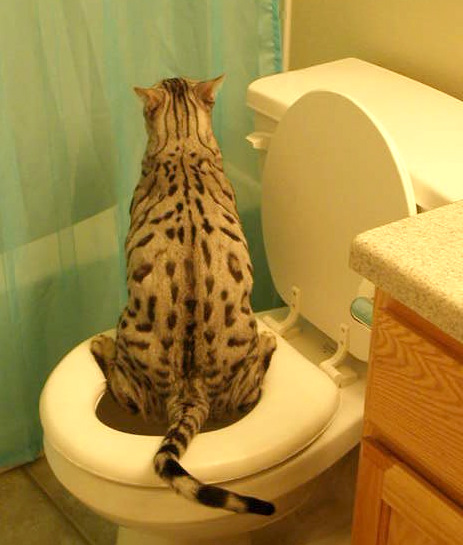Why Flushing Cat Poop Down Your Toilet Isn't a Good Idea - Tips for Proper Handling
Why Flushing Cat Poop Down Your Toilet Isn't a Good Idea - Tips for Proper Handling
Blog Article
What are your thoughts concerning Don’t flush cat feces down the toilet?

Introduction
As cat proprietors, it's important to be mindful of just how we take care of our feline good friends' waste. While it may appear convenient to purge feline poop down the commode, this method can have destructive repercussions for both the environment and human health and wellness.
Ecological Impact
Flushing feline poop introduces dangerous virus and parasites into the water, positioning a significant risk to water ecological communities. These contaminants can negatively affect marine life and concession water top quality.
Wellness Risks
In addition to ecological concerns, flushing cat waste can also position health risks to humans. Cat feces might contain Toxoplasma gondii, a bloodsucker that can create toxoplasmosis-- a potentially severe ailment, particularly for pregnant ladies and individuals with weakened immune systems.
Alternatives to Flushing
Thankfully, there are safer and much more responsible means to throw away pet cat poop. Take into consideration the adhering to alternatives:
1. Scoop and Dispose in Trash
One of the most common method of taking care of feline poop is to scoop it into an eco-friendly bag and throw it in the trash. Make sure to make use of a dedicated trash scoop and throw away the waste promptly.
2. Use Biodegradable Litter
Select naturally degradable pet cat trash made from products such as corn or wheat. These clutters are eco-friendly and can be securely taken care of in the garbage.
3. Hide in the Yard
If you have a lawn, consider burying pet cat waste in a marked area away from veggie yards and water sources. Make certain to dig deep sufficient to avoid contamination of groundwater.
4. Install a Pet Waste Disposal System
Purchase an animal waste disposal system especially developed for pet cat waste. These systems utilize enzymes to break down the waste, reducing smell and ecological influence.
Final thought
Responsible family pet possession extends past offering food and sanctuary-- it also includes correct waste management. By avoiding purging cat poop down the bathroom and going with alternative disposal techniques, we can lessen our ecological footprint and protect human health and wellness.
Why Can’t I Flush Cat Poop?
It Spreads a Parasite
Cats are frequently infected with a parasite called toxoplasma gondii. The parasite causes an infection called toxoplasmosis. It is usually harmless to cats. The parasite only uses cat poop as a host for its eggs. Otherwise, the cat’s immune system usually keeps the infection at low enough levels to maintain its own health. But it does not stop the develop of eggs. These eggs are tiny and surprisingly tough. They may survive for a year before they begin to grow. But that’s the problem.
Our wastewater system is not designed to deal with toxoplasmosis eggs. Instead, most eggs will flush from your toilet into sewers and wastewater management plants. After the sewage is treated for many other harmful things in it, it is typically released into local rivers, lakes, or oceans. Here, the toxoplasmosis eggs can find new hosts, including starfish, crabs, otters, and many other wildlife. For many, this is a significant risk to their health. Toxoplasmosis can also end up infecting water sources that are important for agriculture, which means our deer, pigs, and sheep can get infected too.
Is There Risk to Humans?
There can be a risk to human life from flushing cat poop down the toilet. If you do so, the parasites from your cat’s poop can end up in shellfish, game animals, or livestock. If this meat is then served raw or undercooked, the people who eat it can get sick.
In fact, according to the CDC, 40 million people in the United States are infected with toxoplasma gondii. They get it from exposure to infected seafood, or from some kind of cat poop contamination, like drinking from a stream that is contaminated or touching anything that has come into contact with cat poop. That includes just cleaning a cat litter box.
Most people who get infected with these parasites will not develop any symptoms. However, for pregnant women or for those with compromised immune systems, the parasite can cause severe health problems.
How to Handle Cat Poop
The best way to handle cat poop is actually to clean the box more often. The eggs that the parasite sheds will not become active until one to five days after the cat poops. That means that if you clean daily, you’re much less likely to come into direct contact with infectious eggs.
That said, always dispose of cat poop in the garbage and not down the toilet. Wash your hands before and after you clean the litter box, and bring the bag of poop right outside to your garbage bins.
https://trenchlesssolutionsusa.com/why-cant-i-flush-cat-poop/

As an enthusiastic reader on Don’t flush cat feces down the toilet, I was thinking sharing that piece of content was necessary. In case you appreciated our blog posting if you please be sure to share it. I enjoy reading our article about Can You Flush Cat Poo or Litter Down the Toilet?.
Schedule Service Now Report this page